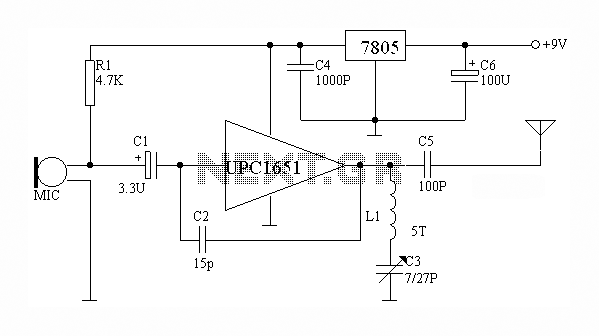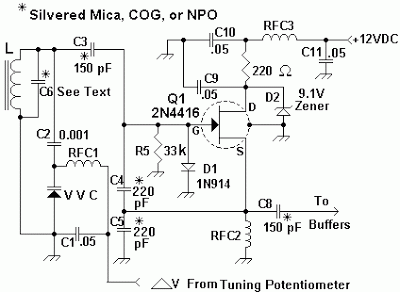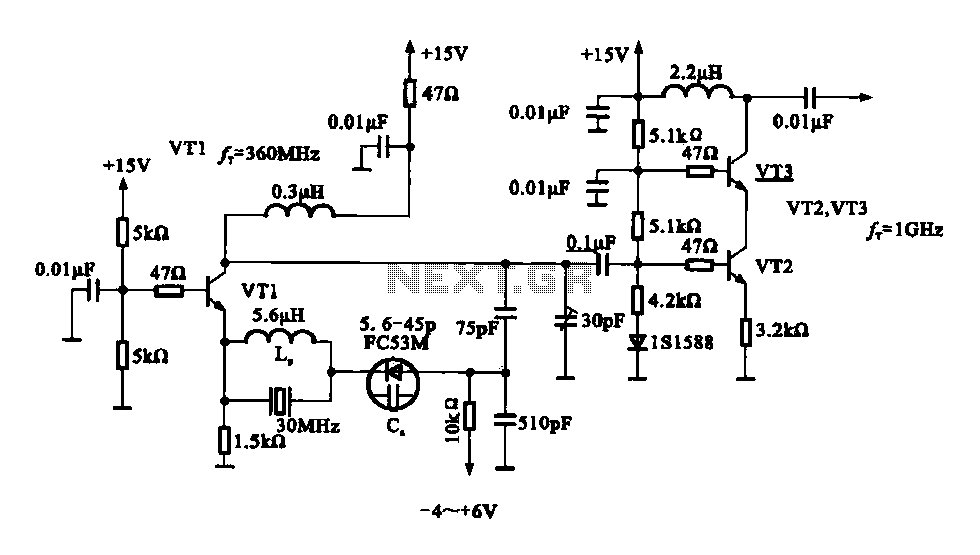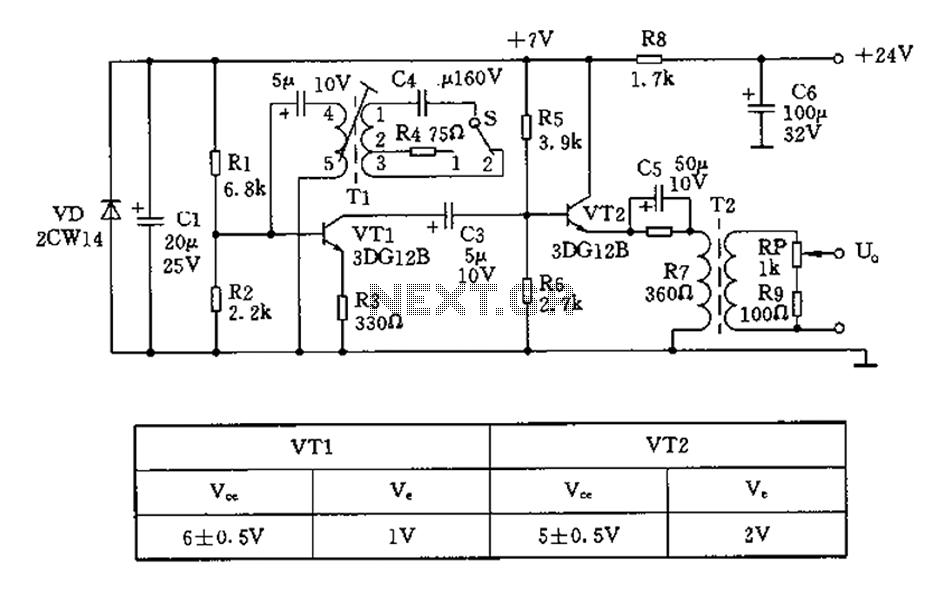
Using several resistive and capacitive phase shifting trigger circuit
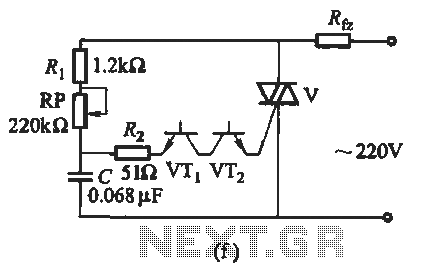
The introduction for a unidirectional thyristor trigger circuit is also applicable to the TRIAC. Various configurations are presented in Figure 16-28. Figures 16-28 (a) and (b) illustrate a direct trigger circuit; Figure 16-28 (c) depicts a dual diode trigger circuit; Figure 16-28 (d) shows a configuration with two light-emitting diodes arranged in inverse parallel for triggering; Figure 16-28 (e) introduces a neon bulb trigger circuit; Figure 16-28 (f) presents a trigger circuit using two NPN diodes (such as the 3DG6); Figure 16-28 (g) demonstrates a trigger circuit with two anti-parallel diodes; Figure 16-28 (h) illustrates a triode diac trigger circuit; and Figure 16-28 (i) introduces a series regulator touch reverse hair circuit.
The unidirectional thyristor trigger circuit serves as a fundamental component in controlling AC loads through the TRIAC, which allows for bidirectional current flow. In the configurations shown in Figure 16-28, various methods of triggering the TRIAC are explored, each offering unique advantages depending on the application requirements.
Figures 16-28 (a) and (b) detail direct trigger circuits that utilize simple resistor-capacitor (RC) networks to provide the necessary gate current to the TRIAC. These configurations are straightforward and effective for low-power applications.
In Figure 16-28 (c), a dual diode trigger circuit is presented, which enhances the triggering capability by allowing control over both halves of the AC waveform. This configuration is particularly useful in applications requiring precise phase control.
The arrangement of two light-emitting diodes in inverse parallel, as shown in Figure 16-28 (d), provides a visual indication of the circuit's operation while simultaneously serving as a triggering mechanism. This approach is beneficial in applications where visual feedback is essential.
Figure 16-28 (e) introduces a neon bulb trigger circuit, which is known for its simplicity and reliability in triggering thyristors at a specific voltage threshold. This method is often used in light dimmers and other household appliances.
The use of two NPN diodes in Figure 16-28 (f) illustrates a more robust approach to triggering, allowing for higher current handling and improved performance in demanding applications. The selected diodes, such as the 3DG6, are capable of withstanding high reverse voltages.
In Figure 16-28 (g), the anti-parallel diode configuration is explored, which provides a fail-safe mechanism by ensuring that the TRIAC can be triggered regardless of the polarity of the input AC signal.
The triode diac trigger circuit depicted in Figure 16-28 (h) offers a unique triggering mechanism that enhances the precision of the TRIAC's activation point. This is particularly advantageous in applications requiring fine control over power delivery.
Lastly, Figure 16-28 (i) presents a series regulator touch reverse hair circuit, which integrates a touch-sensitive interface to control the TRIAC. This innovative approach allows for user-friendly operation in modern electronic devices.
Overall, the various trigger circuits illustrated in Figure 16-28 provide a comprehensive overview of the different methods available for controlling TRIACs in various applications, highlighting the versatility and adaptability of thyristor technology in modern electronics.The introduction for unidirectional thyristor trigger circuit is equally applicable to the TRIAC. Here are some also for bidirectional circuit shown in Figure 16-28. Figure 16-28 (a) and (b) is a direct trigger circuit; Figure 16-28 (c) for the dual diode to trigger the trigger circuit; Fig. 16-28 (d) for the introduction of two light-emitting diodes in inverse parallel trigger circuit; Figure 16-28 (e) for the introduction of neon bulbs trigger circuit; Figure 16-28 (f) for the introduction of two NPN diode (such as 3DG6, etc.) of the trigger circuit; Figure 16-28 (g) for the introduction of two anti-parallel diode trigger circuit; Figure 16-28 (h) for the introduction of a triode diac trigger circuit; Fig.
16-28 (1) for the introduction of two series regulator touch reverse hair circuit.
The unidirectional thyristor trigger circuit serves as a fundamental component in controlling AC loads through the TRIAC, which allows for bidirectional current flow. In the configurations shown in Figure 16-28, various methods of triggering the TRIAC are explored, each offering unique advantages depending on the application requirements.
Figures 16-28 (a) and (b) detail direct trigger circuits that utilize simple resistor-capacitor (RC) networks to provide the necessary gate current to the TRIAC. These configurations are straightforward and effective for low-power applications.
In Figure 16-28 (c), a dual diode trigger circuit is presented, which enhances the triggering capability by allowing control over both halves of the AC waveform. This configuration is particularly useful in applications requiring precise phase control.
The arrangement of two light-emitting diodes in inverse parallel, as shown in Figure 16-28 (d), provides a visual indication of the circuit's operation while simultaneously serving as a triggering mechanism. This approach is beneficial in applications where visual feedback is essential.
Figure 16-28 (e) introduces a neon bulb trigger circuit, which is known for its simplicity and reliability in triggering thyristors at a specific voltage threshold. This method is often used in light dimmers and other household appliances.
The use of two NPN diodes in Figure 16-28 (f) illustrates a more robust approach to triggering, allowing for higher current handling and improved performance in demanding applications. The selected diodes, such as the 3DG6, are capable of withstanding high reverse voltages.
In Figure 16-28 (g), the anti-parallel diode configuration is explored, which provides a fail-safe mechanism by ensuring that the TRIAC can be triggered regardless of the polarity of the input AC signal.
The triode diac trigger circuit depicted in Figure 16-28 (h) offers a unique triggering mechanism that enhances the precision of the TRIAC's activation point. This is particularly advantageous in applications requiring fine control over power delivery.
Lastly, Figure 16-28 (i) presents a series regulator touch reverse hair circuit, which integrates a touch-sensitive interface to control the TRIAC. This innovative approach allows for user-friendly operation in modern electronic devices.
Overall, the various trigger circuits illustrated in Figure 16-28 provide a comprehensive overview of the different methods available for controlling TRIACs in various applications, highlighting the versatility and adaptability of thyristor technology in modern electronics.The introduction for unidirectional thyristor trigger circuit is equally applicable to the TRIAC. Here are some also for bidirectional circuit shown in Figure 16-28. Figure 16-28 (a) and (b) is a direct trigger circuit; Figure 16-28 (c) for the dual diode to trigger the trigger circuit; Fig. 16-28 (d) for the introduction of two light-emitting diodes in inverse parallel trigger circuit; Figure 16-28 (e) for the introduction of neon bulbs trigger circuit; Figure 16-28 (f) for the introduction of two NPN diode (such as 3DG6, etc.) of the trigger circuit; Figure 16-28 (g) for the introduction of two anti-parallel diode trigger circuit; Figure 16-28 (h) for the introduction of a triode diac trigger circuit; Fig.
16-28 (1) for the introduction of two series regulator touch reverse hair circuit.
